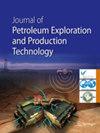Study on rock brittleness characteristics of deep volcanic reservoir under different confining pressures
IF 3.2
4区 工程技术
Q3 ENERGY & FUELS
Journal of Petroleum Exploration and Production Technology
Pub Date : 2023-11-01
DOI:10.1007/s13202-023-01717-z
引用次数: 0
Abstract
Abstract The mechanical properties of deep volcanic reservoir rocks are complex and the brittleness characteristics are not clear. In order to study the brittleness characteristics of deep volcanic rocks, triaxial compression tests and XRD tests under different confining pressures were carried out to study the brittleness characteristics of deep volcanic rocks. Three methods were used to evaluate the brittleness of volcanic rocks from different sides: the brittleness evaluation method based on stress–strain curve characteristics (BI 1 ), the brittleness evaluation method based on energy dissipation (BI 2 ) and the brittleness evaluation method based on mineral composition (BI 3 ). The three methods showed that the brittleness index of volcanic rocks decreases with the increase in confining pressure, and the higher the depth of volcanic rocks, the lower the brittleness. On the basis of previous studies, an improved brittleness evaluation method based on internal friction Angle was proposed, and the obtained evaluation results were almost consistent with the results obtained by the brittleness evaluation method based on stress–strain curve characteristics (BI 1 ) and the brittleness evaluation method based on energy dissipation (BI 2 ), indicating the feasibility of the improved brittleness evaluation method. The brittleness characteristics of deep volcanic rocks are clearly defined to provide reference for the exploration and development of deep volcanic rocks reservoir.

不同围压下深部火山岩储层岩石脆性特征研究
摘要深层火山岩储层力学性质复杂,脆性特征不明确。为了研究深部火山岩的脆性特征,开展了不同围压下的三轴压缩试验和XRD试验,研究了深部火山岩的脆性特征。采用基于应力-应变曲线特征的脆性评价方法(BI 1)、基于能量耗散的脆性评价方法(BI 2)和基于矿物成分的脆性评价方法(BI 3),从不同角度对火山岩脆性进行了评价。三种方法均表明,火山岩脆性指数随围压的增大而减小,且火山岩埋深越深,脆性指数越低。在前人研究的基础上,提出了一种改进的基于内摩擦角的脆性评价方法,得到的评价结果与基于应力-应变曲线特征的脆性评价方法(BI 1)和基于能量耗散的脆性评价方法(BI 2)的脆性评价结果基本一致,表明改进的脆性评价方法的可行性。明确了深部火山岩的脆性特征,为深部火山岩储层的勘探开发提供了参考。
本文章由计算机程序翻译,如有差异,请以英文原文为准。
求助全文
约1分钟内获得全文
求助全文
来源期刊
CiteScore
5.90
自引率
4.50%
发文量
151
审稿时长
13 weeks
期刊介绍:
The Journal of Petroleum Exploration and Production Technology is an international open access journal that publishes original and review articles as well as book reviews on leading edge studies in the field of petroleum engineering, petroleum geology and exploration geophysics and the implementation of related technologies to the development and management of oil and gas reservoirs from their discovery through their entire production cycle.
Focusing on:
Reservoir characterization and modeling
Unconventional oil and gas reservoirs
Geophysics: Acquisition and near surface
Geophysics Modeling and Imaging
Geophysics: Interpretation
Geophysics: Processing
Production Engineering
Formation Evaluation
Reservoir Management
Petroleum Geology
Enhanced Recovery
Geomechanics
Drilling
Completions
The Journal of Petroleum Exploration and Production Technology is committed to upholding the integrity of the scientific record. As a member of the Committee on Publication Ethics (COPE) the journal will follow the COPE guidelines on how to deal with potential acts of misconduct. Authors should refrain from misrepresenting research results which could damage the trust in the journal and ultimately the entire scientific endeavor. Maintaining integrity of the research and its presentation can be achieved by following the rules of good scientific practice as detailed here: https://www.springer.com/us/editorial-policies

 求助内容:
求助内容: 应助结果提醒方式:
应助结果提醒方式:


